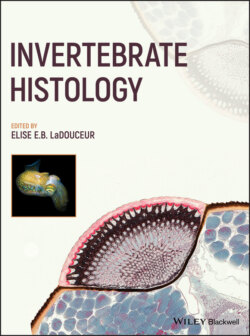Читать книгу Invertebrate Histology - Группа авторов - Страница 21
1.3.6 Immune System
ОглавлениеCoelomocytes exist within the fluid of the coelomic cavity, water vascular system, and hemal system, and are seen throughout all tissues of the body (Holland et al. 1965). They play diverse roles including nutrient delivery, waste excretion, phagocytosis, immune response, clotting, and wound healing. Nine different coelomocyte types have been described in sea stars (Kanungo 1984) but by light microscopy these cell types are not discernible. Some discerning features are evident using electron microscopy. Coelomocytes in echinoids include phagocytes (amoebocytes), spherule cells, and vibratile cells (Cavey and Märkel 1994), best distinguished by cytology. Phagocytes are the most abundant and may have cytoplasmic foreign material. Vibratile cells are small, round, and flagellated. Coelomocytes with eccentric nuclei and cytoplasmic inclusions are nonphagocytic and often referred to as granular or spherule cells, which are further named according to the color of their inclusions (i.e., red or colorless). Red spherule cells contain echinochrome, a red naphthaquinone pigment. In holothuroids there are six different types of coelomocytes recognized, including morula cells, amoebocytes, crystal cells, fusiform cells, vibrate cells, and lymphocytes. By light microscopy, however, only two coelomocyte types, hyalinocytes (agranulocytes) and granulocytes, are discernible (Xing et al. 2008). Hyalinocytes are characterized by a central nucleus and scant cytoplasm lacking granules. Granulocytes share similar features but have fine granular cytoplasm.
